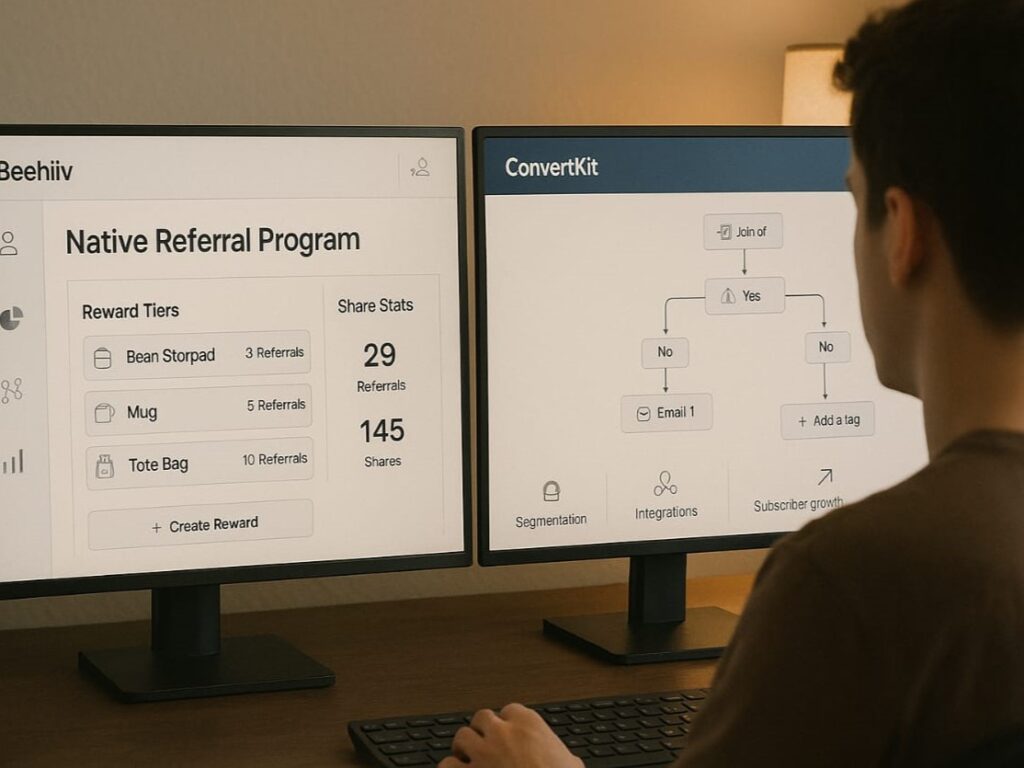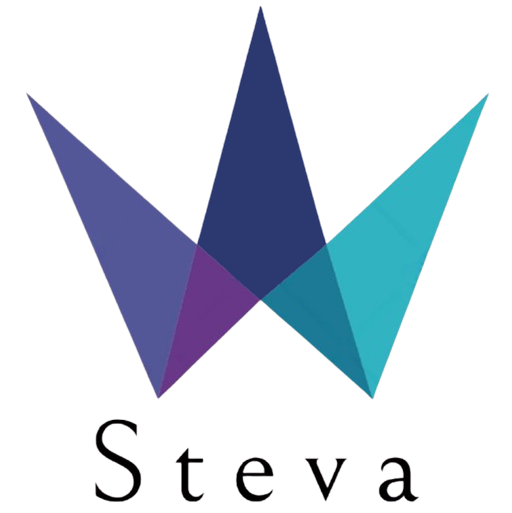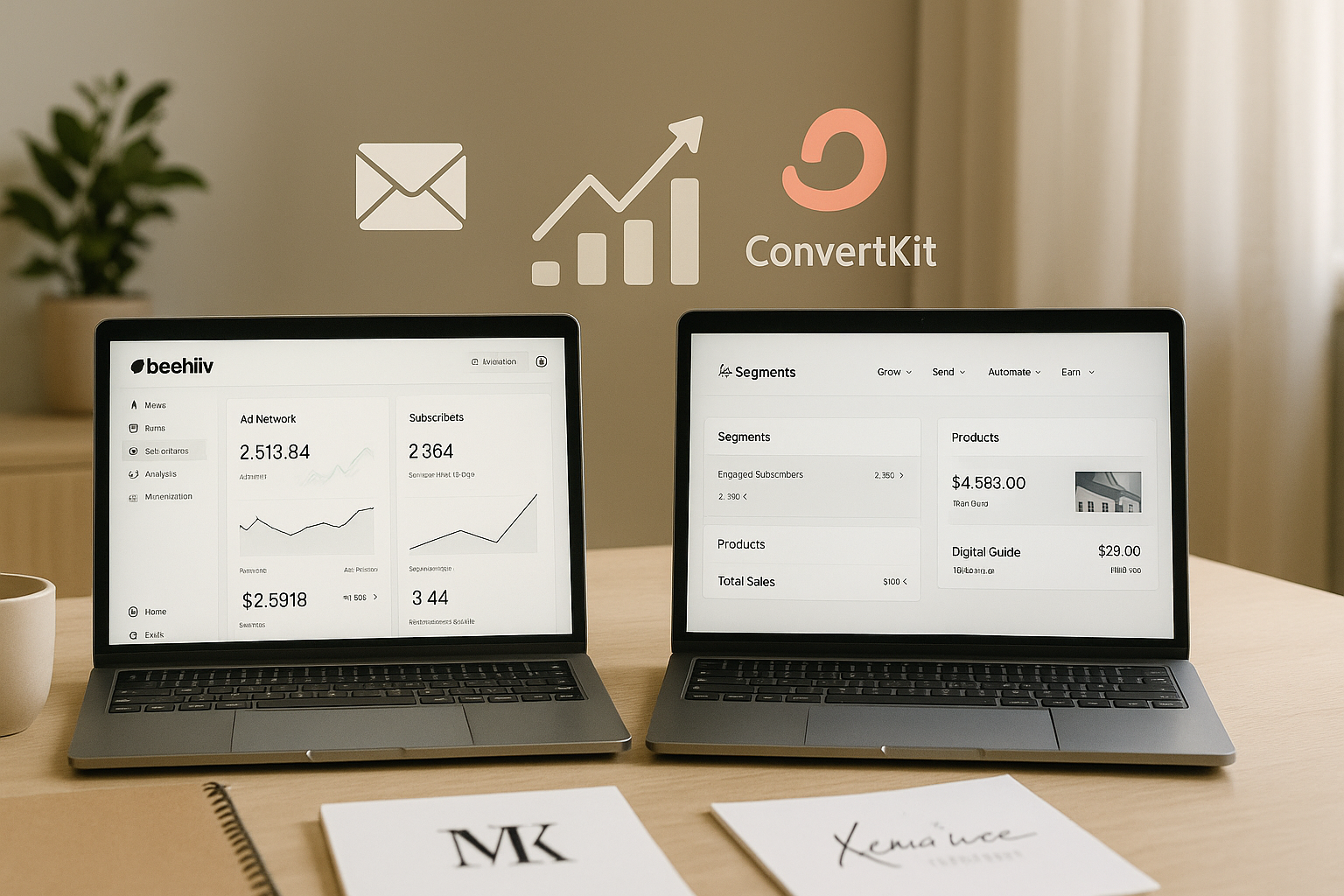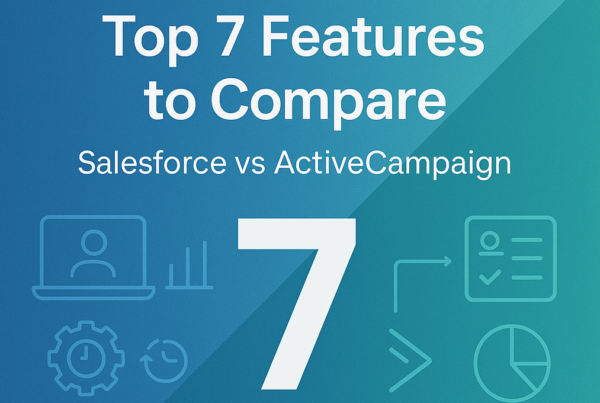When it comes to beehiiv vs ConvertKit, choosing the right newsletter platform can significantly impact your content creation journey and monetization potential. The email industry is projected to reach $17.9 billion by 2027, making your platform choice more important than ever for capturing this growing market.
Founded in 2021 by former Morning Brew employees, beehiiv offers a generous free plan supporting up to 2,500 subscribers. Kit (formerly ConvertKit) caps its free tier at 1,000. Both platforms present distinct advantages, but beehiiv excels with its built-in Ad Network and user-friendly interface. However, Kit stands out with powerful audience segmentation and digital product selling capabilities. Whether considering pricing differences or weighing the pros and cons of each platform’s features, this comparison will help you determine which tool best suits your newsletter growth strategy.
Let’s dive into how Beehiiv vs ConvertKit compare across key areas like creation tools, monetization options, customization features, and growth capabilities. We’ll also cover Beehiiv vs ConvertKit pricing, highlight their pros and cons, and provide an honest Beehiiv vs ConvertKit review to help you choose the best fit for your newsletter needs.
Supercharge your emails with Mailchimp’s drag-and-drop editor. Perfect for creators scaling past newsletters, connect with ConvertKit or Beehiiv for ultimate campaign control.
Comparison Table: Beehiiv vs ConvertKit
| Feature | Beehiiv | ConvertKit (Kit) |
| Free Plan Limit | 2,500 subscribers | 10,000 subscribers |
| Editor Type | Modern drag-and-drop (According to Campaign Refinery) | Minimalist WYSIWYG |
| Subscription Fee | 0% commission | 0.6% fee |
| Ad Network | Built-in Ad Network ($1.00 per click as noted by FatStacks) | Sponsor Network (CKSN, requires 10,000+ subscribers) |
| Digital Product Sales | Not available | Available with 3.5% + $0.30 per transaction |
| Templates | Customizable, mobile-responsive layouts | Pre-designed email templates |
| AI Writing Support | Built-in AI assistant | Not available |
| Referral System | Native built-in system | SparkLoop integration |
| Website Builder | Native website builder (According to Email Tool Tester) | Landing page builder |
| Automation | Basic sequences | Advanced automation (According to FatStacks) |
| Segmentation | Static, dynamic, and manual segments | Tag-based system |
| Large List Pricing | $249/month for 75,000 subscribers (According to High Signal) | $499/month for 75,000 subscribers |
| Multiple Publications | Up to 3 on same plan | Not mentioned |
| HTML Support | Strong HTML and JavaScript handling (Noted by Expression Bytes) | Occasional rendering issues |
| Integrations | Primarily through Zapier | 100+ direct integrations |
Content Creation and Editor Experience

The editor experience forms the foundation of your newsletter creation process. Both beehiiv vs ConvertKit offer distinct approaches to content creation that cater to different creator preferences and workflow styles.
1. Editor Interface: Clean WYSIWYG vs Drag-and-Drop
Beehiiv provides a modern drag-and-drop editor that gives publishers greater visual control over their newsletters. According to Campaign Refinery, beehiiv’s interface allows for more visual customization options, making it especially appealing for creators who want highly designed newsletters. The editor presents a clean, intuitive layout with easy access to formatting tools through a simple plus icon menu.
In contrast, ConvertKit (now Kit) embraces a minimalist WYSIWYG (What You See Is What You Get) approach that prioritizes content over design. As highlighted by several sources, this deliberate design philosophy stems from Kit’s email marketing approach that favors plain text for better inbox placement and deliverability. The interface presents content on the left and settings on the right for a streamlined experience.
One notable limitation with ConvertKit, pointed out by FatStacks, is the lack of an “undo” function in the editor, a surprising omission in 2023 that can lead to frustrating content loss situations.
Convert clicks into subscribers. Use Unbounce with Beehiiv or ConvertKit to build stunning, A/B-tested landing pages that grow your email list faster.
2. Formatting Tools: HTML Blocks, Polls, and Templates
Beehiiv excels with its comprehensive formatting toolkit that includes:
- URL embed feature that automatically populates featured images and titles
- Custom HTML blocks with reliable rendering
- Audience polls for engagement
- Paywall functionality for premium content
ConvertKit offers a more focused set of formatting options, including text formatting, file uploads, countdown timers, and HTML blocks. However, some users report occasional issues with HTML rendering. Both platforms provide templates, but their approaches differ fundamentally.
ConvertKit offers pre-designed email templates that give creators a head start with minimal customization needed. Meanwhile, beehiiv’s template system provides more diverse, mobile-responsive layouts specifically designed for newsletter content. Expression Bytes notes that beehiiv handles HTML and JavaScript better in their editor, an important consideration for creators who need advanced customization.
Launch your brand with a beautiful website on Squarespace. Then embed Beehiiv or ConvertKit to turn visitors into loyal subscribers with zero coding.
3. AI Writing Support: Beehiiv’s Assistant vs Kit’s Simplicity
Beehiiv now includes built-in AI writing tools, helping creators brainstorm, refine ideas, and improve content directly within its editor. These features are praised as “creative block-breakers” by Knocked Up Money when inspiration starts running dry.
- ConvertKit favors clean writing over built-in AI, aligning with its simplicity-first philosophy.
- Beehiiv’s URL embed feature makes it the best choice for curating content with images, per FatStacks.
- Beehiiv also offers inline comments and collaboration tools that are ideal for team-based newsletter creation.
ConvertKit remains streamlined for solo creators, while beehiiv supports creators who need stronger tools for curation and team workflows.
Need a traditional tool with modern features? Constant Contact offers event marketing, email templates, and list growth tools paired with ConvertKit for deeper automations.
Monetization Features and Revenue Options

Turning your newsletter audience into revenue requires effective monetization tools. Both beehiiv vs ConvertKit offer distinct approaches to help creators generate income, with notable differences in fee structures and available options.
1. Paid Subscriptions: 0% Fee vs 0.6% Fee
A key distinction between these platforms lies in their subscription fee policies. Beehiiv stands out by taking 0% commission (Source: Beehiiv) on paid subscriptions, allowing creators to keep all their subscription revenue beyond standard payment processing fees. Conversely, ConvertKit charges a modest 0.6% fee on subscription transactions.
This difference becomes increasingly significant as your subscriber base grows. For instance, on a paid newsletter generating $10,000 monthly, you’d save approximately $60 per month with beehiiv compared to ConvertKit, potentially thousands annually.
Sell courses, host content, and email your list all in one. Kajabi does it all, but ConvertKit offers deeper segmentation if you want more email control.
2. Ad Networks: Beehiiv Ad Network vs Kit Sponsor Network
Both platforms have built native advertising networks to connect creators with potential sponsors, eliminating the need for manual outreach.
The beehiiv Ad Network automatically matches publishers with relevant advertisers and simplifies sponsorship management. As noted by FatStacks, publishers receive payment per click, typically around $1.00 per click. Additionally, beehiiv sends regular lists of potential and opportunities from premium brands that match your audience.
According to Paved.com, ConvertKit provides its Sponsor Network (CKSN), which links creators with sponsors for ad revenue generation. Nevertheless, the blog post highlights that ConvertKit’s eligibility criteria, such as a minimum of 10,000 subscribers and a weekly sending frequency, are different.
3. Digital Products: Available in Kit Only
Unlike beehiiv, ConvertKit excels in digital product sales capabilities. Through ConvertKit Commerce, creators can sell various digital products directly:
- E-books and online courses
- Virtual workshops
- Premium content and printables
- Subscriptions and consultations
This feature is included in all ConvertKit plans with a processing fee of 3.5% + $0.30 per successful transaction[134]. Furthermore, ConvertKit provides integrated product landing pages and checkout functionality, making selling easier without third-party tools.
Running a store? Use Shopify for sales and ConvertKit to re-engage buyers with email funnels, promos, and automations that boost LTV.
4. Boosts and Referrals: Built-in vs SparkLoop Integration
Beehiiv offers native “Boosts,” a cross-promotion system where creators pay to promote their newsletter to subscribers of other newsletters, paying only per acquired subscriber. Furthermore, beehiiv includes built-in referral programs that allow creators to:
- Create unique referral links for subscribers
- Track individual referral performance
- Set up automated rewards for successful referrals
ConvertKit, alternatively, has integrated with SparkLoop following its acquisition. This integration enables ConvertKit users to implement powerful referral programs similar to major newsletters like TheSkimm and Morning Brew. Moreover, according to SparkLoop, this integration can help creators unlock an additional $2.00-5.00 in revenue per subscriber.
Both platforms provide comprehensive monetization tools, yet their strengths lie in different areas. Beehiiv excels with its commission-free subscriptions and native referral system. At the same time, ConvertKit distinguishes itself through its capabilities in digital product sales and SparkLoop integration.
Turn traffic into subscribers with LeadPages’ opt-in forms and pop-ups. Then automate the nurture flow using ConvertKit or Beehiiv.
Customization and Design Flexibility
Your newsletter’s visual identity hinges on design flexibility and customization options. Examining the differences between Beehiiv vs ConvertKit reveals distinct approaches to aesthetics and branding.
1. Newsletter Templates: Kit’s Pre-Built vs Beehiiv’s Custom
One advantage ConvertKit offers is its library of pre-designed email templates that give creators a head start when crafting newsletters. As noted by Feather, these templates provide immediate structure and design foundations, particularly beneficial for busy creators without design experience. The templates often feature muted, professional color schemes suitable for serious content creators.
Beehiiv takes a different approach, foregoing pre-built templates in favor of customizable options you create yourself. According to Expression Bytes, “Beehiiv is the most customizable platform for newsletters without writing code.” This DIY approach requires more initial setup but ultimately provides greater creative control over your newsletter’s appearance.
Build high-converting pages with Instapages for your lead magnets and newsletters. Integrate with Beehiiv or ConvertKit to grow your email list with precision.
2. Website Builder: Beehiiv’s Native Site vs Kit’s Landing Pages
Beehiiv distinguishes itself with a comprehensive native website builder that integrates directly with your newsletter. Email Tool Tester highlights that “Beehiiv offers a native website builder” where you can customize brand colors, fonts, and icons while maintaining consistency between your site and emails.
Conversely, ConvertKit excels with its diverse landing page options. Campaign Refinery indicates that ConvertKit’s system includes templates specifically designed for lead magnets, digital product sales, newsletters, and signups. The platform’s block-based editor allows creators to drag and drop elements while maintaining mobile responsiveness.
Launch your brand with a beautiful website on Squarespace. Then embed Beehiiv or ConvertKit to turn visitors into loyal subscribers with zero coding.
3. Branding Options: Fonts, Colors, and Layout Control
Both beehiiv vs ConvertKit offer strong customization tools, but they cater to different users. ConvertKit focuses on ready-made design elements like fonts, backgrounds, and buttons. At the same time, beehiiv gives creators more visual freedom with layout, typography, and color choices without requiring coding skills or external tools.
- ConvertKit allows nearly full control over newsletter visuals, offering font, button, and background customizations for consistent, branded emails.
- Beehiiv’s no-code design options give creators layout freedom, which is ideal for building unique visual identities from scratch.
- Knocked Up Money notes beehiiv provides “full blog & newsletter control.” At the same time, ConvertKit has “good email design” but fewer blog features.
Colors can boost brand recognition by 80%. ConvertKit is best for users needing instant templates, while beehiiv suits those who value deep customization and design ownership.
Growth and Automation Tools

Growing your subscriber base demands robust tools that automate workflows while driving engagement. Both beehiiv and ConvertKit offer distinctive approaches to newsletter expansion, yet with notable differences in implementation.
1. Referral Programs: Native vs Third-Party
Beehiiv includes a built-in referral system designed by the engineer behind Morning Brew’s successful referral program. This native solution allows creators to set up reward tiers, track individual referrals, and automate rewards for successful shares. Statistics show the potential impact. According to the Referral Rock blog, Morning Brew attributed 30% of their initial subscribers to referrals, noting conversion rates exceeding 85%.
In contrast, ConvertKit integrated with SparkLoop after its acquisition. Through this third-party solution, creators can implement powerful referral programs similar to major newsletters like TheSkimm.
Turn traffic into subscribers with LeadPages’ opt-in forms and pop-ups. Then automate the nurture flow using ConvertKit or Beehiiv.
2. Email Sequences: Visual Workflow Builders
Both platforms provide visual automation builders for creating email sequences. According to EmailToolTester, beehiiv offers powerful automated sequences that let creators send targeted content to different audience segments. Their visual workflow builder helps map email journeys, including triggers and branching paths.
Likewise, ConvertKit excels with its robust automation capabilities. As noted by FatStacks, “ConvertKit beats beehiiv hands down when it comes to automations, segmenting, sequences, and rules. It’s not even close”. The platform’s visual automation setup makes complex audience nurturing straightforward.
Need a traditional tool with modern features? Constant Contact offers event marketing, email templates, and list growth tools, and pairs it with ConvertKit for deeper automations.
3. Subscriber Segmentation: Tags vs Dynamic Lists
Beehiiv employs three segments: static (fixed groups), dynamic (continuously updated based on conditions), and manual. This system enables publishers to group subscribers based on join dates, payment status, and engagement metrics.
Conversely, ConvertKit utilizes a flexible tagging system. EmailToolTester states, “You can tag subscribers based on actions (like whether they bought a product or subscribed to a specific sequence)”. This approach enables more versatile audience targeting.
If you love WordPress, OptimizePress is your go-to for funnel building. Sync it with ConvertKit to build powerful subscriber flows right from your site.
4. Integrations: Zapier vs Native App Marketplace
Integration capabilities differ significantly between platforms. ConvertKit offers over 100 direct integrations with complementary tools. Meanwhile, beehiiv primarily relies on third-party connectors like Zapier and Make.com. This distinction becomes crucial for creators with complex tech stacks requiring seamless platform connections.
Supercharge your emails with Mailchimp’s drag-and-drop editor. Perfect for creators scaling past newsletters, connect with ConvertKit or Beehiiv for ultimate campaign control.
Beehiiv vs ConvertKit Pricing and Scalability
Cost considerations ultimately determine which newsletter platform fits your publishing budget. Let’s dive into how Beehiiv vs ConvertKit pricing compares in terms of structure, value, and long-term scalability.
1. Free Plan Limits: 2,500 vs 10,000 Subscribers
The free tier comparison reveals a notable shift in the market. Initially, beehiiv led with a generous 2,500 subscriber limit on their free plan. According to High Signal.io, ConvertKit responded boldly in late 2024, during its rebrand, by offering a new 10,000 free ‘Newsletter’ plan, noting that being able to gather 10,000 subscribers for free is exceptionally good value.
This difference creates an interesting value proposition: ConvertKit’s free tier offers 4x the subscriber capacity. Yet there’s a trade-off: free ConvertKit users must “recommend” other newsletters to subscribers to sign up.
2. Paid Plan Tiers: Flat Rate vs Subscriber-Based
Both platforms structure their paid plans differently:
Beehiiv embraces a simpler model with their Scale plan starting at $39/month for smaller lists and maxing at $99/month for up to 100,000 subscribers. Meanwhile, ConvertKit employs a subscriber-based pricing model that scales progressively as your audience grows.
This distinction becomes particularly relevant for growth-focused creators. As noted by Expression Bytes, “beehiiv offers only two paid plans that don’t escalate through the roof when you get more subscribers”.
3. Cost Efficiency for Large Lists
For larger audiences, the pricing gap widens considerably. According to High Signal, at the 75,000 subscriber level, beehiiv costs $249/month compared to ConvertKit’s $499/month. For 100,000 subscribers specifically, Feather’s annual plan costs $262/month versus ConvertKit’s steeper $566/month.
This represents significant savings of over $3,600 yearly at the 100,000-subscriber mark.
4. Beehiiv vs ConvertKit Pricing Summary
Consequently, the pricing verdict depends primarily on your audience size and growth trajectory. As Headwest Guide explains, “For those with small lists who plan to lean heavily into selling their products to subscribers, ConvertKit’s pricing will be affordable. However, if you plan on having a larger list, you monetize through newsletter ads, and ConvertKit will become more expensive”.
Plus, beehiiv allows multiple publications (up to 3) on the same plan, providing triple value for creators managing various newsletters.
Beehiiv vs Convertkit Pros and Cons
When comparing Beehiiv vs ConvertKit pros and cons, it’s clear that both platforms offer unique strengths and weaknesses. Understanding these differences helps creators select the right tool based on their newsletter goals, budget, and preferred features.
| Feature | Beehiiv | ConvertKit |
| Pros | Flat-rate pricing for large lists | Advanced automation |
| Built-in AI writing tools | Large template library | |
| Strong ad monetization features | Strong for digital product sales | |
| Collaborative editing | Free tier up to 1,000 subscribers | |
| Excellent content curation tools | Requires newsletter recommendations | |
| Clean, distraction-free interface | ||
| Cons | Limited advanced automation | Higher pricing for large audiences |
| Smaller template variety | Limited AI or creative tools | |
| Less suited for digital product sales | Fewer blog customization options | |
| Newer platform, fewer integrations |
The Beehiiv vs ConvertKit pros and cons balance depends on your focus: choose Beehiiv for monetization and content curation, ConvertKit for automation and product sales. Align your choice with your newsletter’s growth and revenue goals.
Final Thought: Beehiiv vs Convertkit review

Choosing between beehiiv vs ConvertKit depends on your newsletter goals and revenue model. According to High Signal, Beehiiv stands out for its flat-rate pricing, saving over $3,600 annually for 100,000 subscribers. It also offers a commission-free model, full blog and newsletter control, and a drag-and-drop editor ideal for ad-driven or visually-focused newsletters.
On the other hand, ConvertKit is better suited for creators who are selling digital products and using advanced automation. Its recent move to expand the free tier to 10,000 subscribers is bold but requires newsletter recommendations. It excels in segmentation and email design and has strong integrations, making it the top pick for creators with sophisticated marketing strategies.
Ultimately, larger creators prioritizing ad revenue may benefit more from Beehive’s pricing and control. At the same time, smaller digital sellers will find ConvertKit’s tools worth the investment. Choose based on your growth strategy to thrive in the booming $17.9B email industry.
FAQs on beehiiv vs convertkit
Q1. What is the primary difference between beehiiv and ConvertKit’s free plans?
Beehiiv’s free plan supports up to 2,500 subscribers. In contrast, ConvertKit’s free tier allows a significantly larger audience of 10,000 subscribers. Still, it includes a requirement to recommend other newsletters during the signup process.
Q2. How do beehiiv and ConvertKit differ in their editor interfaces?
Beehiiv features a modern drag-and-drop editor, enabling visual customization. Conversely, ConvertKit employs a minimalist WYSIWYG editor, prioritizing content creation over extensive design options. This difference caters to varying user preferences for interface complexity.
Q3. What are the key monetization differences between beehiiv and ConvertKit?
Beehiiv offers a 0% commission on paid subscriptions, maximizing creator earnings. ConvertKit, however, charges a 3.5% + $0.30 transaction fee for digital product sales and a 0.6% fee on paid subscriptions, impacting overall revenue for creators utilizing these features.
Q4. Which platform offers better customization and design flexibility?
Beehiiv provides greater customization through its DIY templates and integrated website builder, offering extensive design control. ConvertKit focuses on ease of use with pre-designed email templates and landing pages, facilitating quicker deployment but with less unique branding potential.





